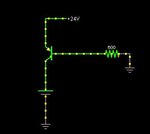Nik_Henri
Newbie level 4
Hi,
I would like to be able to charge a battery pack (12v 6A/h) from a power supply. I can charge it directly if i connect the battery on the power supply but i would like to have switch so i can stop the charge but my MCU. I try to make a very simple circuit that would act has a ON/OFF switch but i cant get my PNP work in saturation so the current is 600ma (expecting about 2A) and the VCE is 11V (expecting about 0.2v). What am I doing wrong ?
here's the circuit

thx for the help
I would like to be able to charge a battery pack (12v 6A/h) from a power supply. I can charge it directly if i connect the battery on the power supply but i would like to have switch so i can stop the charge but my MCU. I try to make a very simple circuit that would act has a ON/OFF switch but i cant get my PNP work in saturation so the current is 600ma (expecting about 2A) and the VCE is 11V (expecting about 0.2v). What am I doing wrong ?
here's the circuit

thx for the help